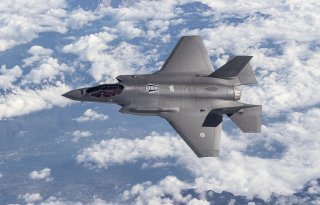Why the U.S. Military Needs the F-35: A War with Russia
As America’s adversaries continue to invest in increasingly sophisticated air and missile defense systems, the F-35 jet’s unique stealth penetration toolkit is more vital than ever.
The state-of-the-art F-35 joint stealth fighter (JSF) program has drawn a new round of unfair media scrutiny following House Armed Services Committee Chairman Adam Smith’s critical remarks earlier this month. And quite sadly, the ensuing debate over the future of the F-35 fighter jet has played out along familiar lines, all too often omitting a key piece of context: the unique and worrisome threat environment in which F-35 jets are designed to operate.
F-35s Are Needed in a Russia Conflict Scenario
It would be a fair criticism to note that Russian Anti Access/Area Denial—better known by the moniker A2/AD—capabilities have been woefully distorted in the popular discourse, frequently reducing complex matters of military analysis to large, red bubbles plastered over maps. As some experts have widely observed, there is no such doctrine or strategy as “A2/AD” in Russian military planning. But these legitimate concerns have branched out into a dangerous new trend of downplaying Russian anti-air and missile defense capabilities altogether.

According to this emerging line of reasoning, advanced platforms like the F-35 program are a hammer in search of a nail—expensive weapons designed to counter inflated or even non-existent threats from Washington’s supposedly inferior opponents. But the reality of Russian military capabilities paints a different picture, restoring much-needed context to the purpose of the F-35 program, and showcasing why this fighter is so badly needed.
Discussions of Russia’s air/missile defenses usually center around the S-400 Triumf, and for good reason: versatile and highly effective, the S-400 has become the recognizable face of Russia’s missile defense efforts. The S-400 system can operate from short to long ranges and can engage up to eighty targets simultaneously. Equipped with a powerful radar suite, the S-400 system can detect and track up to three hundred targets—including manned aircraft, drones, cruise missiles, and ballistic missiles—within a range of roughly six hundred kilometers. But the S-400 doesn’t operate alone; rather, it is the centerpiece of a larger network of missile and air defense installations including the S-300 family, the S-350, Pantsir-S1, and Tor-M1.
These systems work in tandem to provide redundant, overlapping layers of defense to protect key Russian infrastructure and military assets at all possible ranges. When grouped en masse, these systems offset each others’ weaknesses and can mitigate the effectiveness of saturation strikes. The forthcoming S-500, reportedly capable of intercepting hypersonic missiles and aerial targets flying at speeds of over Mach 5, will enhance Russia’s layered missile defenses even further.
Western experts widely acknowledge that there is no easy path to air dominance in the event of a major conventional conflict between Russia and the North Atlantic Alliance Treaty Organization (NATO). There are, however, concrete steps that NATO can take to tilt the correlation of forces in its favor. Russia’s formidable air and missile defenses are well-equipped to engage fourth-generation aircraft and supposed new fighters like the F-15EX, but they remain vulnerable to coordinated applications of fifth-generation stealth technology. This is why the F-35 matters so much to the U.S. military, as Russia’s missile defenses still cannot reliably detect and target low observable aircraft, which are able to reduce the range of Russia’s fire control radars.

F-35: The Essential Strike Fighter
With that said, it's no wonder the U.S. armed forces have made such an important and strategic investment in fifth-generation fighters such as the F-35, a point nearly every major media report that attacks the program seems to miss. In fact, this is precisely the type of high-intensity mission for which the F-35 JSF, one of the world’s stealthiest and most survivable fighters, was built.
The jet's capabilities are one of a kind and ready to deal with not only the A2/AD threat from Russia but also China, North Korea, Iran, and others. With a frontal radar cross-section roughly comparable to that of a metal golf ball, the F-35 jet is one of the few aircraft in the U.S. Air Force roster that’s sufficiently equipped to run successful penetration missions deep into Russian airspace. With its class-leading stealth performance, prodigious suite of onboard sensors, advanced electronic warfare capabilities, and ability to generate a dynamic picture of the battlefield commonly referred to as “sensor fusion,” the F-35 jet is uniquely suited for the demanding task of spearheading suppression and neutralization missions against Russian air defense installations.
As America’s adversaries continue to invest in increasingly sophisticated air and missile defense systems, the F-35 jet’s unique stealth penetration toolkit is more vital than ever. Without it, the Air Force will lapse into a dangerous capabilities gap that would create unnecessary risk, especially in an era of renewed great-power competition.
Mark Episkopos is a national security reporter for the National Interest.

